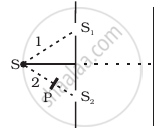Advertisements
Advertisements
प्रश्न
The reflected light is found to be plane polarised when an unpolarized light falls on a denser medium at 60° with the normal. Find the angle of refraction and critical angle of incidence for total internal reflection in the denser to rarer medium reflection.
उत्तर
60° + r + 90° = 180°
60° + r = 90°
r = 30°
Angle of refraction = 30°
c = ?
`mu = 1/(sin "c")`
`mu = (sin "i")/(sin "r")`
`mu = (sin 60)/(sin 30)`
= `(sqrt3/2)/(1/2)`
`= sqrt3`
`mu = 1/(sin "c")`
sin c = `1/mu`
sin c = `1/sqrt3`
c = `sin^-1 (1/sqrt3)`
c = 35.15°
APPEARS IN
संबंधित प्रश्न
Find an expression for intensity of transmitted light when a polaroid sheet is rotated between two crossed polaroids. In which position of the polaroid sheet will the transmitted intensity be maximum?
Using the phenomenon of polarisation, show how the transverse nature of light can be demonstrated.
State any two methods by which ordinary light can be polarised
What does a polaroid consist of? How does it produce a linearly polarised light?
A ray of light is incident on a transparent medium at a polarizing angle. What is the angle between the reflected ray and the refracted ray?
What is polarisation?
What is a analyser?
What is plane polarised light?
What is unpolarised light?
What is partially polarised light?
State and obtain Malus’ law.
Discuss about pile of plates.
What is double refraction?
Which of the following phenomena is not common to sound and light waves?
Figure shown a two slit arrangement with a source which emits unpolarised light. P is a polariser with axis whose direction is not given. If I0 is the intensity of the principal maxima when no polariser is present, calculate in the present case, the intensity of the principal maxima as well as of the first minima.

